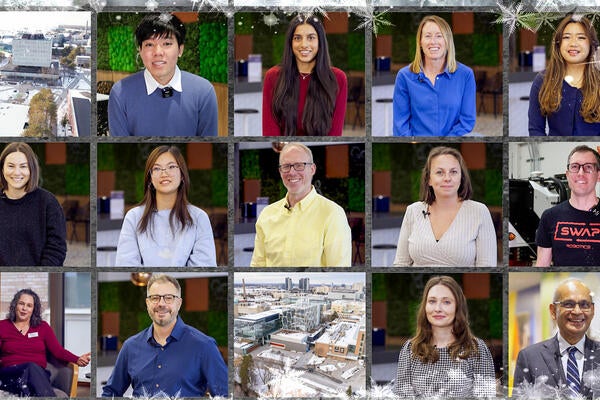
Waterloo’s urban forest receives national healing forest designation
From restoration to interactive maps and art, our community envisions new ways to embody reconciliation on campus

From restoration to interactive maps and art, our community envisions new ways to embody reconciliation on campus
By Chantal Vallis Faculty of EnvironmentAt the north of campus next to Village 1 residences and Westmount Road, lies a small section of urban forest that has recently received big attention. Recognizing how it embodies our spiritual connection to the land and fosters a place to heal from traumas, the space has been designated a national healing forest by the David Suzuki Foundation in partnership with the National Healing Forests Initiative.

The University of Waterloo Urban Forest has witnessed many transitions. The Attawandaron (Neutral) people were one of the earliest known Indigenous Nations to live and farm in the area we now call Waterloo Region. They lived alongside the Haudenosaunee and other Indigenous Nations, who were unequivocally promised the Haldimand Tract for their allegiance with the British during the American War of Independence. The land promised to them included 950,000 acres, but today they own less than five per cent because of the British and Canadian colonial project, which saw the Crown resurvey and redistribute the land in the 19th century. In 1957 the University of Waterloo was founded.
The core area of the urban forest has potentially never been logged and it might be a remnant of the original forest that covered the area before colonization. This is suggested by a forest remnant that is visible in aerial photography from 1955 when the land was still part of a Mennonite farm before the University took ownership of the land. It may be that this forest was not cleared because of its location in the floodplain which made it less suitable for agriculture.
The five-hectare urban forest is the largest remaining wooded green space on the University’s Waterloo campus. It encompasses a creek bed, marshy floodplains and a moist forest with sugar maple, ironwood and black cherry trees. For nearly a decade, the space has been a highlight in the Faculty of Environment’s research and educational activities, as it is fertile ground for field work and projects such as identifying birds, testing soil, and inventorying trees and herbaceous vegetation.
"This forest has been a consistent part of the University’s connection to nature and will help us reflect on new ways we can embody reconciliation on our campus,” said Kelsey Leonard, professor in the School of Environment, Resources and Sustainability and a member of the Faculty of Environment’s Indigenous Curriculum Working Group who collectively applied.
Over the next year, the curriculum group will be working with Indigenous Nations and community partners to define a shared vision for the forest as a place of learning, healing and connecting. The group will also seek resources and other support necessary to realize this vision.
"There is a lot of enthusiasm to envision what the forest could be in the future,” said Leslie Wexler, senior educational developer of Indigenous Knowledges and Anti-Racist Pedagogies who is a member of the Indigenous Curriculum Working Group. “From installing art in the space to creating a digital handbook and walking tour of the forest, the possibilities are already starting to bubble up.”
One key priority for those participating in planning and managing the forest will be healing the forest itself as invasive species, such as garlic mustard and buckthorn trees, are becoming a growing problem through endangering local species and affecting future forest plant communities. While this is a troubling and pressing issue, it is also an example of the exciting opportunities this project presents to bring different approaches to understanding and tackling challenges like invasive species management.
“I want to congratulate the Faculty of Environment’s Indigenous Curriculum Working Group for taking steps to deepen the University’s relationship with the urban forest and make it more accessible to community members,” said Jean Becker, associate vice-president, Indigenous Relations. “This project and other land-based learning projects being planned have enormous potential to advance our Indigenous Strategic Plan goals around placemaking, fostering relationships with community partners and educating scholars about Indigenous research methods and practices.”
The designation was announced on September 28, 2023, just before the National Day of Truth and Reconciliation, and was one of 33 forests that were recognized across the country. The designation aligns with the University’s commitments to decolonization, Indigenization and reconciliation that are grounded in the University’s 2023-2028 Indigenous Strategic Plan.

Read more
Here are the people and events behind some of this year’s most compelling Waterloo stories

Read more
A winter holiday message from President Vivek Goel

Read more
Researchers awarded funding to investigate ecology, climate change, repatriation, health and well-being through cultural and historical lens
The University of Waterloo acknowledges that much of our work takes place on the traditional territory of the Neutral, Anishinaabeg, and Haudenosaunee peoples. Our main campus is situated on the Haldimand Tract, the land granted to the Six Nations that includes six miles on each side of the Grand River. Our active work toward reconciliation takes place across our campuses through research, learning, teaching, and community building, and is co-ordinated within the Office of Indigenous Relations.